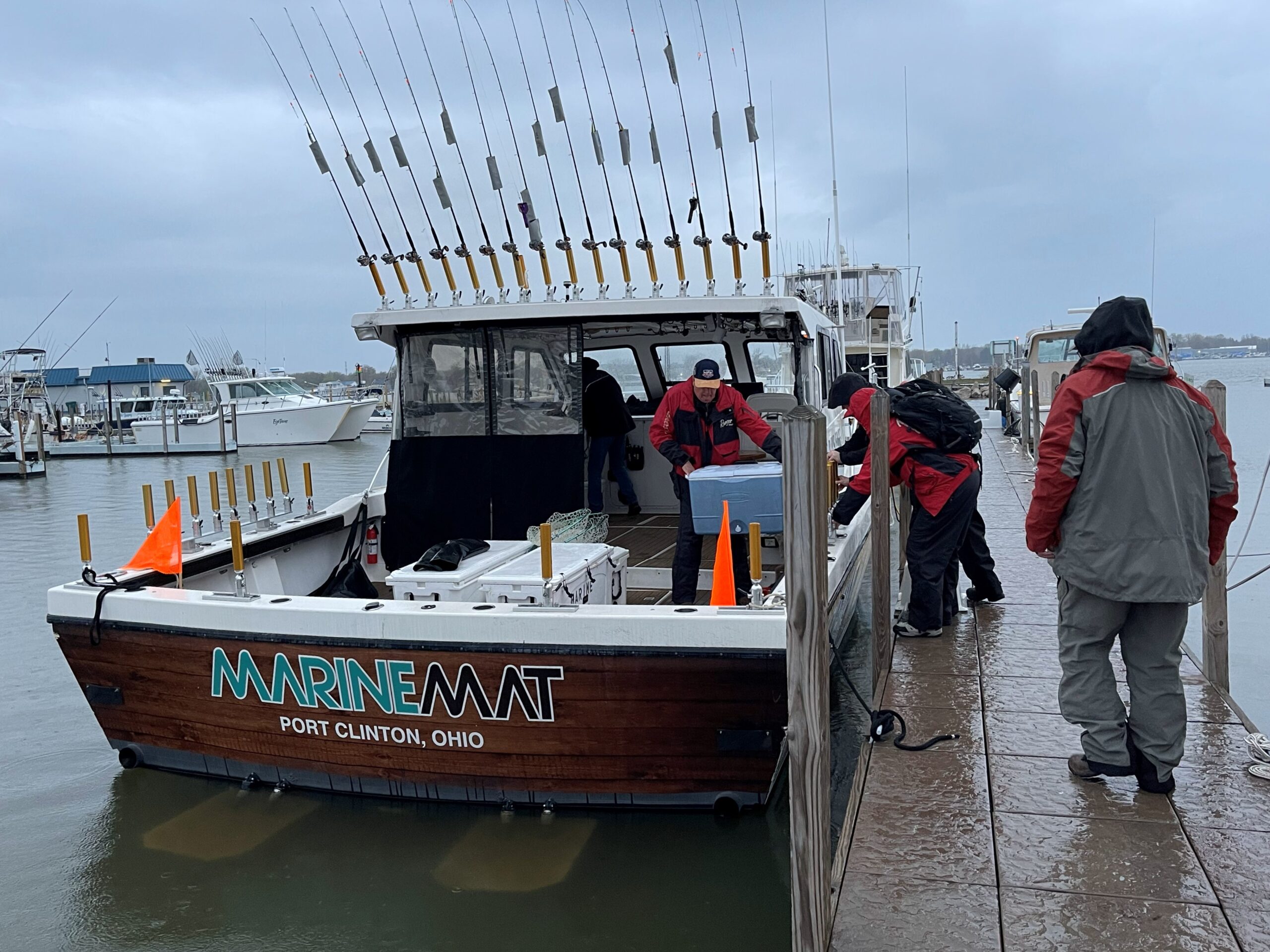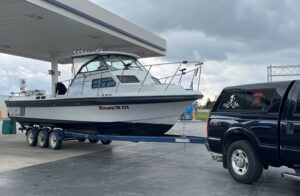
Veteran fishers on Lake Erie fondly recall the late 1980s as a heyday for walleye – a time when Ohio anglers were allowed to catch 10 fish a day and the big-eyed apex predators seemed an endless resource.
At its height in 1988, the Ohio charter fishing industry supported 1,221 licensed captains and nearly 5 million walleye were taken. Over the next two decades, the population plummeted due to a combination of factors including invasive species, native predators and unfavorable weather. Winds from the wrong direction for example pushed tiny reef-born walleye away from food sources, resulting in starvation and predation.
A decade later in 1998, harvested fish numbered about 2.3 million, then dropped further to 1.1 million in 2008. The low point came in 2011 when sports anglers reeled in nearly 417,000 fish.
By 2014, the number of captains licensed in the state had dwindled to 676. Many older captains retired or moved on to other lines of work.
But the last decade has seen the lake’s walleye population skyrocket. Record hatches in conjunction with high survival rates aided by favorable winds, precipitation and food availability, have pushed walleye numbers to near-record highs. In fact, Ohio Department of Natural Resources (ODNR) estimates place the 2023 population of two-years and older fish at the fifth highest level since 1986.
The number of walleye harvested increased 600 percent from 2011 to 2021, to 2.5 million and there are now 945 charter captains in Ohio helping to fuel a sport fishery worth about $1 billion.
According to the Ohio Sea Grant’s latest charter industry survey, 2020 saw nearly 30,000 charter trips booked by 808 captains. Of those trips, 88 percent focused solely on walleye, with yellow perch, smallmouth bass, combination trips and steelhead salmon rounding out the remainder.
The importance of out-of-towners
A lot of people from outside the state come to Lake Erie to fish. During the 2022-2023 license year, non-resident purchases totaled nearly 20 percent of Ohio’s 678,000 sales. The ODNR places Wisconsin, Michigan, Indiana, Kentucky, West Virginia, Pennsylvania and Illinois as the top states. But plates from Iowa, Nebraska, Minnesota and the Dakotas are not an uncommon sight at Western Basin marinas.
At the end of April, Sadi Fieldsend and three companions traveled from South Dakota for a three-day fishing trip with Marblehead-based Mark I Sportfishing. It was a repeat visit for her group. They did their first fishing trip in 2022 because it was on her father’s bucket list and now they’re hooked on the experience, making plans for more.
“We caught a 32.5 inch walleye and had so much fun,” she says. “There’s something to be said about the memories on a boat, the fact that for six to eight hours there’s nothing to do but shoot the breeze, catch some fish and make lasting memories.”
Factoring in transportation, lodging, meals, adult beverages and tips, Fieldsend estimates she and her fellow anglers spent about $2,000 each.


New boats, new ways of fishing
For decades, the go-to boat for charter captains on Lake Erie was the 30-foot Sportcraft (SC30,) manufactured in Perry, Florida. It’s often called a six-pack because they carry up to six anglers, plus a captain and sometimes a first mate.
According to long-time captains, it’s the perfect boat. Unfortunately, the last Sportcraft was manufactured in 2019.
Steve Ashley operates Hawg’n Charters out of Port Clinton and has four of them.
“There’s really no second choice for us,” he says. “It’s the open area in the back. There’s plenty of room for six anglers and the way they’re designed it’s a good haul when you have to run in rough water.”
Chris Clemons operates Lakeland Charters in Port Clinton and he runs five.
“In 2019 a new Sportcraft was $175,000 so they’d really gotten to the point where they were out of charter captains’ price realm with the number of days in our season,” he says. “Right now I have two that are completely rebuilt. That’s what most guys are doing nowadays.”
New engines, new electronics, cosmetic upgrades and a deep regard for SC30s works well for Clemons and others.
“There’s no other boat on the market as far as drift fishing goes that can perform as well as these boats. It drifts sideways, a touch to the bow, which is great for casting off the deck, hanging lures right there in the strike zone for a longer period,” says Clemons. “Ten feet of gunnel, a lot of fishing space on the deck and a hard top with seating to keep people out of the weather. They’re just perfect for what we’re doing.”
While Paul Pacholski, president of the Lake Erie Charter Boat Association, says SC30s will always be number one, he sees a definite trend.
“Smaller boats are becoming more popular because they can be so much more versatile, loading up on a trailer and heading east or west, wherever the fish are biting because they’re not tied to a dock,” he says.
Kevin Swartz, who operates Captain Kevin’s Lake Erie Charters, is among the newer captains and runs a 22-foot Ranger, taking one to three anglers out at time.
“Us smaller boats are more into techniques and experience,” he says. Swartz’ customers can drift, casting bait with one rod, while reeling it in repeatedly. They can also jig or troll, setting baits on many rods while the boat slowly moves.
Swartz says he considers himself more of a guide than a captain, thanks to the small boat experience where captains can spend more time imparting fishing knowledge. Often, that’s exactly what clients want – including customers who arrive at the lake with their own boat but want to spend a day familiarizing themselves with the water and how to fish it.

One of Hawg’n Charters Sportcraft 30s gets fueled up before launching for the season in late April. (Photo Credit: James Proffitt)
A bit of fishing, a bit of science
Ohio State, Heidelberg, University of Toledo – they’ve all tapped charter captains for data from Lake Erie. Pacholski says he and other captains are happy to help. In fact, he instigated the arrangement around 2010, telling scientists that charter captains could help with Lake Erie research.
“We volunteered our services,” he says. “I told them we have everything you need to get water samples on weekly basis. Empower us with what you need to collect and teach us the best way for you to get it.”
Each season, a faithful fleet of captains collects samples and take measurements. And clients help.
“We explain it to the customers – what we’re doing and show them the results of previous weeks’ data,” Pacholski says. “The customers are always interested in it.”
But at its core, the business model requires satisfied clients, and that means fond memories (full cooler of fish not required.)
“I had an autistic child and his dad wanted him to sit on the seat and nothing else so I sat next to him, hooked fish and handed him the rods,” recalls Pacholski. “The outright excitement, and then allowing him to drive the boat. That kid’s joy brought tears to my eyes.”
Catch more news at Great Lakes Now:
A deep dive into disposing waste from East Palestine’s derailment
Solid hatches continue for walleye, but yellow perch are struggling
Featured image: Sadi Fieldsend and fishing crew board their dawn charter in a steady rain recently. (Photo Credit: James Proffitt)
3 Comments
-
Where do the customers on the 22ft vessels go to the restroom?
-
Great article Mr Profit.
-
Your unique perspective on everyday matters is truly refreshing.




